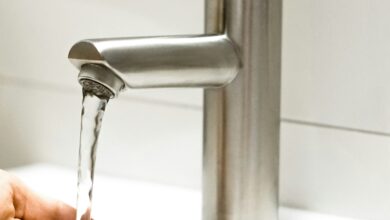The Middle East is running out of water.
It is a statement that may seem both banal and unduly apocalyptic. Most of the land in this arid region is desert. Large oil-exporting states like Saudi Arabia and Libya exhausted their indigenous renewable water supply decades ago. The desalination plants of the Gulf are well known; the Great Manmade River constructed by Libya is notorious. At the same time, water runs freely from the tap in most heavily populated areas of the region. Though it has endured more than its fair share of war, the Middle East has mostly been spared the murderous drought and famine that has accompanied civil strife in the Horn of Africa. The inter-state “water wars” that have been predicted for some time have never been fought and, though the predictions keep coming, these conflicts are not on the horizon.
But the Middle East has entered a new water era, one in which its relative lack of fresh water supply will bump up against growth in demand. The total population of the region—-defined as North Africa, Sudan, Somalia, the Levant, the Arabian Peninsula, Iraq and Iran—-is expected to climb from 309 million in 2000 to about 651 million in 2030. Rising living standards, attained by at least portions of these populations, translate into more water consumption per capita. During the same period the absolute supply of water is projected to decrease, due to drops in precipitation and river flows induced by climate change. The Intergovernmental Panel on Climate Change, the most prestigious body examining the matter, has forecast that “annual rainfall is likely to decrease in much of Mediterranean Africa and northern Sahara, with the likelihood of a decrease in rainfall increasing as the Mediterranean coast is approached.” An independent study published in Nature magazine likewise estimated that regional rainfall could decrease by 10–30 percent by the year 2050.
The combined impact of climate change and population growth will add to the number of countries confronting “water stress”—-the point when demand occasionally exceeds supply or the available water is too brackish or polluted to be used. The Middle East is already the most water-stressed region in the world. In 2000, 15 of its 21 countries fell below the global standard for adequate supply—-1000 cubic meters (about 35 cubic feet) of water per capita per year. (The non-stressed six were Lebanon, Iraq, Mauritania, Oman, Sudan and Syria. Oman and Syria are projected to face stress by 2025.) According to the UN Development Program, Gaza is one of the most water-stressed places on earth, with about 320 cubic meters annually per person.
What will water stress look like on the ground? At the very least, more states will shift the water burden onto the household, as the authorities have already done, for all intents and purposes, in Jordan, Palestine and Yemen. As many people in those countries already must, households will need to arrange for expensive private water delivery, endure water rationing and store water in tanks on the roof. The poor will increasingly be forced to obtain water informally, by dipping a few jugs in irrigation ditches each day or paying prices much higher than those of conventional water delivery systems. As in Iraq, where sanctions and war have severely degraded the water supply system, and the poor have long siphoned off their drinking water in such ways, the public health consequences are dire. Children are the most vulnerable to waterborne disease and contaminants. Although Middle Eastern states have made major strides in ensuring potable water and sanitation, water is not safe everywhere.
How have Middle Eastern states coped with actual and emerging water scarcity? Long ago the region consumed the water resources necessary to supply the population with food. The highest-profile strategy pursued by states has been construction of massive waterworks—-dams for the water-rich, desalination plants for the water-poor—-to expand arable land and supply burgeoning populations with water. But as Tony Allan famously argues, the real solution to aridity has been trading in “virtual water,” embedded not only in food but also industrial products that require water in their manufacture. The import of virtual water, enabled in part by oil revenues, allowed regimes to foster a myth of wise water management and plentiful supply.
This myth is unlikely to survive the stresses of the new water era. Instead, authorities will cope with growing water scarcity by shifting water out of agriculture. On average, agriculture accounts for approximately 80 percent of centrally allocated state water budgets. If trends associated with climate change continue—-declining precipitation, higher temperatures and lower surface water flows—-farmers will require more water to irrigate at the same time that governments find it necessary to reroute supply to sprawling cities. Much of the Great Manmade River water intended for farms has already been diverted for industrial and household use.
Thus far, agricultural planning has not really accounted for water scarcity. Instead, the myth of food security through state management has persisted. In Egypt, the Ministry of Irrigation’s biggest investments in the late 1990s were in large-scale land reclamation. Designed to increase Egypt’s habitable area from 4 to 25 percent, such projects included the el-Salam Canal from the Nile to northern Sinai and the diversion of Nile water to parts of the Toshka depression in southwestern Egypt. Egypt built the world’s largest pumping station—-named after President Husni Mubarak—-to irrigate the fields they hoped agribusiness would till. Toshka has, by most accounts, been a flop. The pumping station uses only a fraction of its capacity, due to lack of demand. Ironically, Libya’s Great Manmade River at least fulfills its initial intent: to transport fossil water hundreds of miles from underneath the barren interior to the populated coastline through a network of pipes. Though costly and fraught with engineering and administrative problems, this “solution” to water scarcity has been considered cheaper than building desalination plants.
Perhaps the strangest story is that of Saudi Arabia. As Toby Jones details in this issue, in the 1970s the regime largely drained the water-richest area of the kingdom, the Eastern Province, in pursuit of the oil underground. Saudi Arabia drew on fossil aquifers to irrigate vast circles of desert near the Empty Quarter, one of the most desolate environments on the planet, to raise wheat and other crops. Simultaneously, the regime began subsidizing wheat growers, to the extent that by the mid-1990s the country had huge wheat surpluses. The amber waves of grain among the sand dunes were guzzling water, however, and the regime was forced to slash the subsidies in 1993. Saudi Arabia reportedly plans to phase out wheat production by 2016, but it remains likely that agribusiness has shifted to other water-intensive crops.
This editorial is republished courtesy of MERIP.




